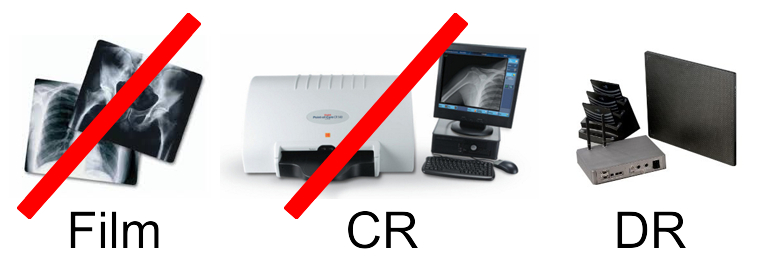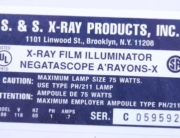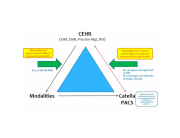There is a widely published report that Medicare will reduce payments for analog x-ray studies in 2017 and that in 2018, it will begin to reduce payments for CR as well. It is clear that reimbursement rates for film studies will drop by 20% in 2017, but it is also reported that the initial rate cuts for CR will be 7% in 2018, increasing to a total of 10% in 2023.
An article by Brian Casey of AuntMinnie.com (http://www.auntminnie.com/index.aspx?sec=sup&sub=xra&pag=dis&itemId=113334) points out that according to a 2013 IMV study, fixed analog general x-ray rooms made up just 1% of the installed base at U.S. hospitals, down from 5% in 2010. So the impact of Medicare’s decision is de minimis for hospitals. However, the percentage of small practices still using film is higher.
Although CR sales, according to the Casey article, were just 6% of new “digital sales” in 2015, CR still makes up 51% of the digital install base in US hospitals. Again, I would venture it is a much larger percentage in the non-hospital market.
A drop of 7% in the reimbursement rate for CR in 2018 would be significant and might lead medical providers to panic. If you are still using film, the 20% drop might be particularly significant if private insurers were to follow the Federal Government’s lead.
A 7% drop could be a significant motivation to stop sales of CR systems and move everyone to DR. That’s certainly what some equipment vendors seem to be inferring in emails I’ve read from them. It’s certainly a great strategy on their part.
For the large clinic and hospital market, the government’s decision really means they need to budget for change, but where does this leave the small x-ray user?
I believe you have step back and do the following calculation:
- First, find out how much your payment will be reduced from the most common studies you do if you now use film or a CR.
- Second, determine the number of studies you do annually. (You might as well use your total study number and not just Medicare since private insurers generally adopt changes in Medicare reimbursement rates in fairly short order.)
- Multiply your answers to 1 and 2 to get your potential lost annual reimbursement.
Now that you know your potential cost increases, you can determine what you want to do.
You have three choices: accept the revenue loss, change technologies or stop doing x-rays altogether.
Let’s take a look at changing technologies.
Here are some “ballpark” costs of new and used equipment in the DR and CR areas.
- Lowest option – Good used CR – $10-15,000. This could be a little higher or lower depending on the age of the unit, what your local dealer “owns” it for, the number of cassettes included and whether the dealer is providing any sort of warranty.
- Next lowest option – New CR – $19-25,000. With new CR’s you will get a warranty but the number of cassettes and other options will determine the final price.
- Highest cost option – DR – Generally there is very little used DR available on the market today so I’m not going to discuss this option. New DR can cost between $30-45,000. This depends on whether the unit is wireless, tethered or fixed….that’s highest to lowest cost. If you only do standing studies you could use a fixed unit in your wall bucky. (Caution: There are less expensive DR options that use CCD chips. My personal opinion is “be careful”. Ask for sample images, particularly of lateral views, before considering these.)
Now divide your annual lost revenue into the cost of your selected upgrade equipment and ask yourself if the transaction makes financial sense.
If you currently have a good and newer CR, you may get some trade-in credit from your dealer, but don’t expect it to be much ($0-$5,000 is the typical range). In most cases, I think you might get $1-3,000. Systems using Windows OS XP are almost worthless today due to HIPAA issues, so the resale value of anything older than 2009 is questionable.
There are some other things to consider:
- Technology is getting cheaper every year. I believe that the retail cost of a good DR panel is heading towards $15,000 within the next five years.
- I believe you will see the beginning of a market for used DR within two years.
- There is a chance that industry groups and medical professionals will make enough of a fuss about reimbursement reductions for CR use that it will not happen. Remember that the 7% reduction starts in 2018 and there may be hearings at the CMS (Centers for Medicare & Medicaid Services – cms.gov) this quarter if you want to complain.
So here’s my summary.
- If you are still using film, you should consider upgrading your technology to avoid the upcoming 20% reimbursement reduction. In addition, I think digital images have come of age and the software for viewing digital images really now outweighs all arguments about still using film (except cost, of course). If you are using an electronic medical records system it is also a great asset to be able to include these images in patient files.
- I think moving from film to a used CR system makes the most sense for smaller practices. If you want my preferences on brands, give me a call.
- DR is the best technology, but the costliest. If you have a very busy practice or you have the money, consider this option, but waiting a few years to buy this technology could save you a lot of money.
I hope this was helpful.
You can contact me for more information. I’m happy to give anyone in the community my thoughts. The disclaimer is that I sell pre-owned imaging equipment, but the good thing is that I’ll give you my honest advice whether or not I can help you with a prospective purchase or sale.
Daniel Giesberg
310.471.8900 ext 300








Leave A Comment